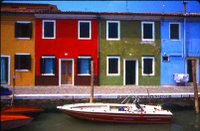

A version of this story was posted in Feb. 2005.
St. Valentine was Italian.
Well, not technically Italian, as Italy didn't exist in the third century when the priest, Valentine, stood on the side of love and married young couples in defiance of Roman emperor Claudius II's decree that young men could not wed. The emperor had decided that unattached men made better soldiers than their married counterparts. Valentine, a make love not war type, performed marriages anyway and paid with his life.
It fits that the man whose life legend gave rise to a holiday celebrating love came from what is now Italy, a land to which I could return and return endlessly. Beauty and romance; gold sun and glistening moon; breeze and blue water; rich flavors and bold colors; languid afternoons and shimmering evenings. Italy isn't a country; it's a state of mind, a sensual experience to be savored.
Love was in the air when we visited Burano, a tiny island in the lagoon that surrounds Venice. Like a giant box of crayons, Burano bursts with houses painted in brilliant shades of purple, blue, green, red, orange, yellow. The streets are palettes of gorgeous, crazy colors.
As we walked Burano's main street, wide, cobbled and built aside the canal that flows through town, I saw a homemade flyer taped to the window of a small shop. Two fresh faces -- the kind Valentine must have looked on -- smiled from the poster, which read, "Walter & Paola oggi Sposi." "Walter and Paola to marry today." Cheek to cheek and arms around one another, Walter and Paola announced their love and intentions to all of Burano.
I hoped they'd put up the poster that morning. Then, "oggi" would mean "today" literally, not just in translation. Perhaps we'd see a wedding.
We headed to the broad, cobbled piazza that held Burano's ancient church and looked up at its campanile, which tilted some 15 degrees. We'd seen the askew bell tower from the water on our approach to the island, and now we stood under it, wondering what kept it from toppling into the square.
The piazza began to fill up with people in their Sunday best. It wasn't Sunday. We smelled nuptials. We were about to see Paola marry Walter.
We did our best to blend in with the wedding guests, but our backpacks looked grossly obtrusive in the sea of graceful lace umbrellas that many of the women carried to shield their creamy faces from the sun. Burano lace is prized, and each of the exquisite, handmade umbrellas -- some bright white, others a velvety black -- was a work of art. I stood behind some of the women, studying and photographing the intricate, dreamy patterns as the sun played on the umbrellas.
Just before noon, the bride appeared. The crowd in the piazza formed a hushed horseshoe as Paola walked up Burano's medieval main street on her beaming father's arm. The train of Paola's snow-white wedding dress brushed over the centuries-old paving stones as she made her way to the church door. There, her father lifted her veil, kissed her, and smiled into her eyes. The wedding party and guests entered the church.
We didn't want our backpacks to spoil things, so we watched the ceremony through the church window. As Wagner's Wedding March thundered from the organ and filled Burano with the sound of joy and hope and love, Paola glided up the aisle and joined Walter at the altar. The crayon houses seemed to break into smiles.
Oggi sposi. Married today. St. Valentine would have loved it.
